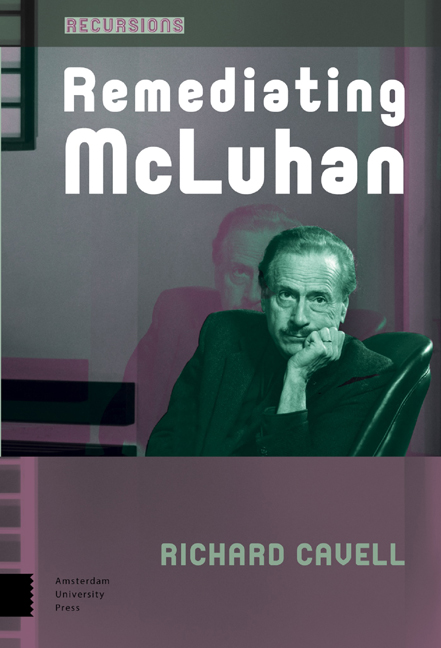Book contents
- Frontmatter
- Dedication
- Contents
- Introduction
- List of sigla
- I
- Re: Mediation
- 1 Beyond McLuhanism
- 2 McLuhan and the Question of the Book
- Embodiment as Incorporation
- 3 McLuhan and the Body as Medium
- 4 McLuhan, Tactility, and the Digital
- 5 Mechanical Brides and Vampire Squids
- Empathic Media
- 6 McLuhan: Motion: e-Motion: Towards a Soft Ontology of Media
- 7 Re-Mediating the Medium
- Determining Technology
- 8 McLuhan, Turing, and the Question of Determinism
- 9 Angels and Robots
- Being Mediated
- 10 Marshall McLuhan’s Echo-Criticism
- 11 McLuhan and the Technology of Being
- II
- 12 The Tragedy of Media: Nietzsche, McLuhan, Kittler
- Coda: On the 50th Anniversary of Understanding Media
- Notes
- Works Cited
- Index
7 - Re-Mediating the Medium
Published online by Cambridge University Press: 12 December 2020
- Frontmatter
- Dedication
- Contents
- Introduction
- List of sigla
- I
- Re: Mediation
- 1 Beyond McLuhanism
- 2 McLuhan and the Question of the Book
- Embodiment as Incorporation
- 3 McLuhan and the Body as Medium
- 4 McLuhan, Tactility, and the Digital
- 5 Mechanical Brides and Vampire Squids
- Empathic Media
- 6 McLuhan: Motion: e-Motion: Towards a Soft Ontology of Media
- 7 Re-Mediating the Medium
- Determining Technology
- 8 McLuhan, Turing, and the Question of Determinism
- 9 Angels and Robots
- Being Mediated
- 10 Marshall McLuhan’s Echo-Criticism
- 11 McLuhan and the Technology of Being
- II
- 12 The Tragedy of Media: Nietzsche, McLuhan, Kittler
- Coda: On the 50th Anniversary of Understanding Media
- Notes
- Works Cited
- Index
Summary
for Douglas Coupland
Electronic Man approaches the condition in which it is possible to deal with the entire environment as a work of art. […] This new possibility demands total understanding of the artistic function in society. It will no longer be possible merely to add art to the environment.
McLuhan and Parker, Through the Vanishing Point (1968)It is entirely appropriate to be considering Marshall McLuhan's work at the Moderna Museet in the context of the ‘post-medium condition’ since this museum has an intimate connection to one of McLuhan's most provocative comments about the nature of art. Writing in The Medium is the Massage (1967), McLuhan (with Quentin Fiore and Jerome Agel) superimposed his notion that ‘art is anything you can get away with’ over an image of Nikki de Saint Phalle's monumental She: A Cathedral, photographed in its Moderna Museet installation of 1966. This 82 foot / 28 metre-long sculpture contained music rooms, a cinema and aquarium, and a milk bar in one of the breasts. The sculpture conveys in iconic fashion a number of McLuhan's chief assertions about the function of the work of art in the electronic era: that art was interactive; performative; collective; total; tactile; libidinal; involving; and, especially, environmental. The risqué nature of the image also encoded McLuhan's notion that the artist was at once a critic and a renegade.
McLuhan's media theory was inextricably tied to his ideas about art; in fact, he understood the mediascape as a vast work of art, which, like de Saint Phalle's sculpture, we had come to inhabit. This notion immediately serves to undermine traditional notions of the separation of art and its cultural contexts and, as such, raises a number of theoretical questions about art in its post-medium condition, a condition where the traditional genres of the visual arts—primarily painting and sculpture—no longer seem to hold, and in which we seem to have moved towards a practice-based understanding of the artistic medium. And what can media theory tell us about these shifts?
As I have argued in McLuhan in Space, McLuhan, by mid-career (that is, post Understanding Media, published in 1964), increasingly sought to address himself to artists and, more radically, to be understood as an artist himself—the ‘intellectual as vates’ as he put it: the critic as creator.
- Type
- Chapter
- Information
- Remediating McLuhan , pp. 79 - 88Publisher: Amsterdam University PressPrint publication year: 2016



